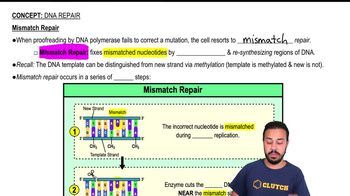The term trace elements refers to
a. the elements CHONPS.
b. vitamins.
c. nitrogen, phosphorus, and sulfur.
d. small mineral requirements.
e. toxic substances.
 Verified step by step guidance
Verified step by step guidance



The term trace elements refers to
a. the elements CHONPS.
b. vitamins.
c. nitrogen, phosphorus, and sulfur.
d. small mineral requirements.
e. toxic substances.
Briefly describe the components of DNA, and explain its functional relationship to RNA and protein.
Identify and mark each of the following on the portion of DNA undergoing replication: replication fork, DNA polymerase, RNA primer, parent strands, leading strand, lagging strand, the direction of replication on each strand, and the 5′ end of each strand. <IMAGE>
The following is a code for a strand of DNA.<IMAGE>
a. Using the genetic code provided in Figure 8.8, fill in the blanks to complete the segment of DNA shown.
b. Fill in the blanks to complete the sequence of amino acids coded for by this strand of DNA.
c. Write the code for the complementary strand of DNA completed in part (a).
d. What would be the effect if C were substituted for T at base 10?
e. What would be the effect if A were substituted for G at base 11?
f. What would be the effect if G were substituted for T at base 14?
g. What would be the effect if C were inserted between bases 9 and 10?
h. How would UV radiation affect this strand of DNA?
i. Identify a nonsense sequence in this strand of DNA.
Which sequence is the best target for damage by UV radiation: AGGCAA, CTTTGA, or GUAAAU? Why aren’t all bacteria killed when they are exposed to sunlight?
Outline the treatment process for drinking water.